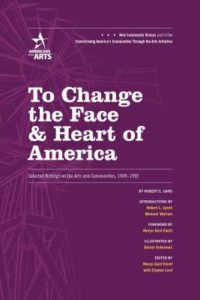
When my good friend Maryo Gard Ewell asked me to write a reflection on the Gard Foundation/Americans for the Arts collaborative collection of Robert Gard’s writings (To Change the Face & Heart of America), I was more than willing. Eager would probably not be a stretch.
When I began teaching arts management, I remember Gard’s The Arts in the Small Community almost leaping off the library shelf at me. His insistence on the importance of the arts to all people and of communities to the arts resonated with me from the moment I encountered his work. I have since discovered that as a high school student in Iowa my life was transformed by a summer program he was instrumental in supporting in Wisconsin. And, as long-time readers of Engaging Matters know, I happily served on the board of the Robert E. Gard Foundation.
To prepare for this blog post I re-read what we on the Gard board affectionately call “the purple book,” this time with copious underlining and dog-earing of pages. Many themes emerge from that, and many of my most cherished ideas, among them the role of the “arts establishment” in this work (the need to pay attention to communities) and the role of the arts council. I have long held that the arts council. or as we now sometimes say–the local arts agency, is vital to the work of connecting the arts with communities.
However, for my purposes here I want to focus on just two of Gard’s important concerns. First is participation in the arts. A centerpiece of Gard’s work was the creation of opportunities for “ordinary” people to write about their own experiences and present them on stage. He was a theater person at heart. He believed that everyone should be encouraged to express themselves artistically. This was both a conviction borne out of faith in humanity and a pragmatic understanding of the importance of participation in building support for the arts. Here are just three quotes from the book that address participation:
- The arts . . . are not reserved for the wealthy, or for the well-endowed museum the gallery, or the ever-subsidized regional professional theater. . . . The people, if shown the way, can create art in and of themselves.
- We substituted the wonderful words joy fulfillment, comprehension, change of attitude, and selfless participation as concepts and values as good or better than the thin “professional” requirements.
- My part is in the back country, away from the largest centers, where the hardest battle is being fought. My part and work is with the creative force that is in the people, and this creative power, developed slowly, in keeping with the life of the people, might finally swell the idea of the arts to a national spiritual crescendo.
In the end, it was this participation in creative work that Gard felt might be “the only sure way toward wide acceptance of the arts.”
The other idea I want to highlight here is Gard’s emphasis on “the grass roots.” Gard writes about this eloquently and often.
- The springs of the American spirit are at the grass roots.
- It is the grassroots where the essence of art
Most joyously flourishes. - I do fully believe that the greatness of American arts must lie in the seeding ground of the home place.
However, and I in no way mean this as criticism, since Gard’s work focused like a laser beam on Wisconsin and, in particular, rural Wisconsin, there is a danger that today’s reader of this book might equate grass roots with rural and white. If Gard were writing and working today I have no doubt that his conception of the grass roots would include people living in both urban and rural environments. His passion was to find and tap the creative genius in all people. That is an easy case to make given the philosophical framework he presents so clearly. And, it is the case that we on the board of the Gard Foundation made in helping it broaden its focus from Wisconsin to the whole country and all of its widely disparate parts–rural communities, urban neighborhoods, and native populations.
It might seem astonishing that a man who retired in 1970 could have been so prescient about the need to involve everyone in the arts. Upon reflection, I see his convictions coming not from clairvoyance but from abiding faith in the human spirit and human potential as well as understanding of the need for the “arts establishment” to tap into that vast reservoir of creativity for its own well-being if not survival.
Thank you Mr. Gard.
Engage!
Doug
